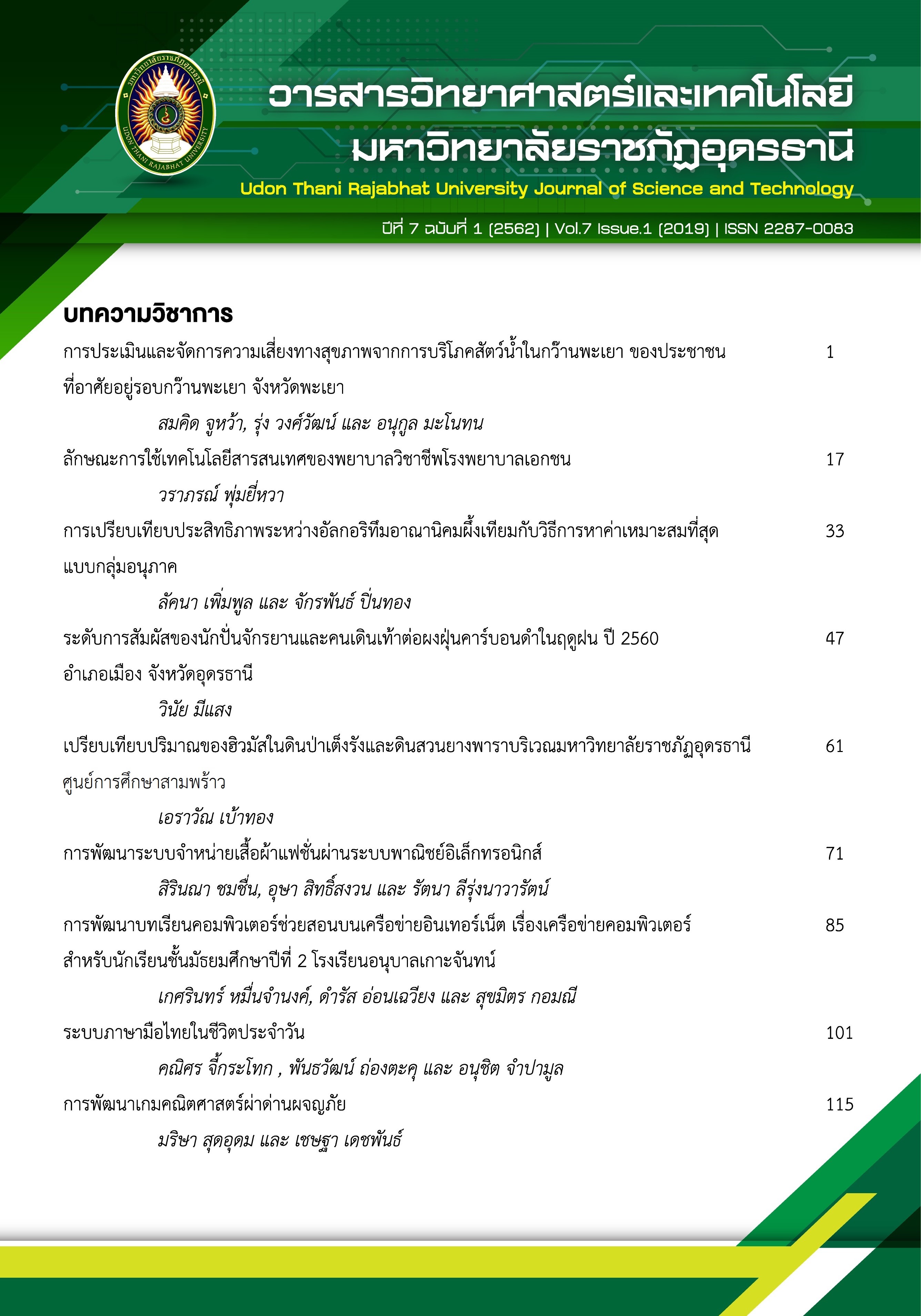A COMPARISON BETWEEN ARTIFICIAL BEE COLONY ALGORITHM AND PARTICLE SWARM OPTIMIZATION
Main Article Content
Abstract
Artificial Bee Colony Algorithm (ABC) and Particle Swarm Optimization are among popular swarm intelligences for tackling optimization. Both algorithms mimic the behaviors of social swarms’ foraging behaviors in nature. ABC mimics the forging behavior of colonies of ants and PSO mimics the forging behavior of flocks of birds. This article presents and compares performances between PSO and ABC with different eight benchmark test functions. The results show that PSO is suitable for solving unimodal problems while ABC is most suitable for multimodal problems.
Article Details
Section
Research Article
References
บุญเจริญ ศิริเนาวกุล. (2555). ปัญญาประดิษฐ์: ปัญญาเชิงกลุ่ม. กรุงเทพมหานคร: ท้อป.
Hedar, A. (2018) Test Functions for Unconstrained Optimization, Retrieved from https://www-optima.amp.i.kyoto-u.ac.jp/member/student/hedar/ Hedar_files/TestGO.htm
Karaboga, D. (2005). An Idea Based on Honey Bee Swarm for Numerical Optimization. Technical Report-TR06, Erciyes University, Engineering Faculty, Computer Engineering Department, Turkey.
Karaboga, D. & Akay B. (2009). A Comparative study of artificial bee colony algorithm. Applied Mathematics and computation, 214(1), 108-132.
Karaboga, D. & Akay, B. (2009). A Survey: Algorithms Simulating Bee Swarm Intelligence; Artificial Intelligence Review, 31 (1), 61-85.
Sindhya, K. (2012). An Introduction to Nature Inspired Algorithms. Industrial Optimization Group, 1-36.
Molga, M. & Smutnicki, C. (2005). Test functions for optimization needs, Retrieved March 1, 2019, from https://www.robertmarks.org/ Classes/ENGR5358/ Papers/functions.pdf
Eberhart, R. C. & Kennedy, J. (1995). Particle Swarm Optimization. Proceedings of the 1995 IEEE International Conference on Neural Networks, 4, 1942-1948.
Eberhart, R. C. & Kennedy, J. (1995). A New Optimizer Using Particle Swarm Theory. Proceedings of the 6th International Symposium on Micro Machine and Human Science, 6, 39-43.
Sharma, S. & Bhambu, P. (2016). Artificial Bee Colony Algorithm: A Survey. International Journal of Computer Applications, 149(4), 11-19.
Surjanovic, S. & D, Bingham, D. (2017). Optimization Test Functions and Datasets, Retrieved from https://www.sfu.ca/~ssurjano/index.html
Hedar, A. (2018) Test Functions for Unconstrained Optimization, Retrieved from https://www-optima.amp.i.kyoto-u.ac.jp/member/student/hedar/ Hedar_files/TestGO.htm
Karaboga, D. (2005). An Idea Based on Honey Bee Swarm for Numerical Optimization. Technical Report-TR06, Erciyes University, Engineering Faculty, Computer Engineering Department, Turkey.
Karaboga, D. & Akay B. (2009). A Comparative study of artificial bee colony algorithm. Applied Mathematics and computation, 214(1), 108-132.
Karaboga, D. & Akay, B. (2009). A Survey: Algorithms Simulating Bee Swarm Intelligence; Artificial Intelligence Review, 31 (1), 61-85.
Sindhya, K. (2012). An Introduction to Nature Inspired Algorithms. Industrial Optimization Group, 1-36.
Molga, M. & Smutnicki, C. (2005). Test functions for optimization needs, Retrieved March 1, 2019, from https://www.robertmarks.org/ Classes/ENGR5358/ Papers/functions.pdf
Eberhart, R. C. & Kennedy, J. (1995). Particle Swarm Optimization. Proceedings of the 1995 IEEE International Conference on Neural Networks, 4, 1942-1948.
Eberhart, R. C. & Kennedy, J. (1995). A New Optimizer Using Particle Swarm Theory. Proceedings of the 6th International Symposium on Micro Machine and Human Science, 6, 39-43.
Sharma, S. & Bhambu, P. (2016). Artificial Bee Colony Algorithm: A Survey. International Journal of Computer Applications, 149(4), 11-19.
Surjanovic, S. & D, Bingham, D. (2017). Optimization Test Functions and Datasets, Retrieved from https://www.sfu.ca/~ssurjano/index.html


